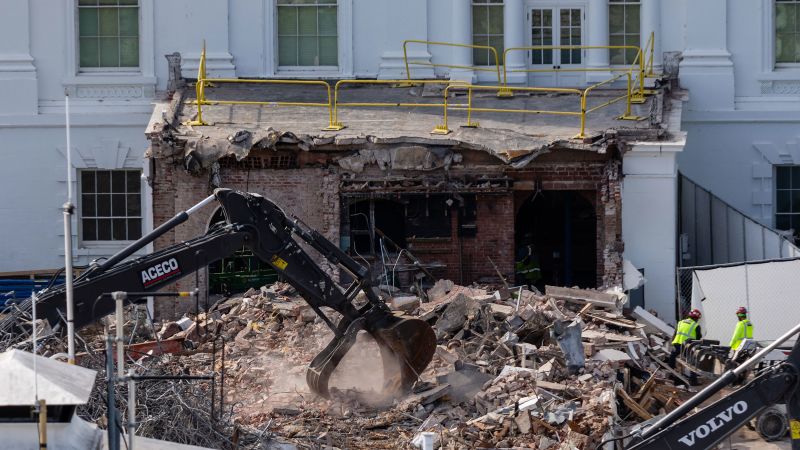Politics
Trump Demolishes East Wing, Unveils Plans for Grand Ballroom

The demolition of the East Wing of the White House has begun, marking a significant shift in the presidential landscape under Donald Trump. Over the course of just a few days, demolition teams have dismantled this historic structure, which has long served as a space for the First Lady and a symbol of historical continuity. This drastic change is part of Trump’s ambitious plan to construct a new ballroom, estimated to cost around $300 million.
Visitors to the White House often express surprise at its size, particularly in the West Wing, where key offices are closely situated. The building, while majestic, offers an intimate atmosphere. The East Wing, characterized by its white-columned entrance and wood-paneled corridors, has hosted many significant moments in American history, from John F. Kennedy’s contemplative portraits to Barack Obama’s announcement of the killing of Osama bin Laden in May 2011.
Trump’s decision to demolish the East Wing has faced backlash from various sectors, including preservationists and historians, who criticize the move as emblematic of a presidency marked by destruction rather than preservation. Critics argue that this act, along with Trump’s previous renovations—such as altering the iconic Rose Garden—reflect a broader disdain for historical integrity.
While some defenders of Trump’s actions point to past renovations by presidents like Franklin D. Roosevelt and Harry Truman, who also made significant changes to the White House, they note that no modern president has pursued such a stark transformation. The proposed ballroom is envisioned to be nearly twice the size of the current White House, measuring at least 90,000 square feet, and adorned with Trump’s signature gold leaf.
During a recent meeting with NATO Secretary General Mark Rutte, Trump showcased plans for this new facility, diverting attention from critical discussions about global security. Critics argue that the lavish nature of the ballroom contrasts sharply with the pressing issues facing many Americans, including rising costs of living and healthcare.
The East Wing’s demolition serves as a tangible representation of Trump’s presidency, illustrating a willingness to prioritize personal ambitions over collective historical legacy. The image of heavy machinery tearing down the structure may come to symbolize an administration that has often prioritized spectacle over substance.
Many Americans question the significance of this demolition in the larger context of national challenges. The state of the economy, characterized by high grocery prices and escalating rent, has led many to wonder if such grand projects are out of touch with the realities faced by everyday citizens.
While Trump has expressed a vision for the new ballroom as a necessary venue for state functions, the juxtaposition of such a project against the backdrop of economic hardship raises concerns about priorities. The administration’s willingness to allocate significant resources for a lavish gathering space, while proposing a $20 billion bailout for Argentina, has drawn skepticism.
The East Wing’s destruction coincided with a surge in protests against Trump, where demonstrators rallied under the banner “No Kings,” emphasizing the democratic values that the White House is meant to represent. The modesty of the White House stands in contrast to the grandeur of European palaces, symbolizing the American commitment to a government that serves the people rather than one that elevates its leaders above them.
As Trump’s plans unfold, there remains uncertainty about how this new ballroom will be perceived in the long run. While he may aspire to be recognized as one of America’s great builders, the potential for the project to become a monument to excess raises questions about the administration’s legacy. Whether this venture will be seen as a mark of innovation or a symbol of arrogance may depend on how it aligns with the needs and sentiments of the American populace in the years to come.
-

 Lifestyle5 months ago
Lifestyle5 months agoLibraries Challenge Rising E-Book Costs Amid Growing Demand
-

 Sports4 months ago
Sports4 months agoTyreek Hill Responds to Tua Tagovailoa’s Comments on Team Dynamics
-

 Sports4 months ago
Sports4 months agoLiverpool Secures Agreement to Sign Young Striker Will Wright
-

 Lifestyle4 months ago
Lifestyle4 months agoSave Your Split Tomatoes: Expert Tips for Gardeners
-

 Lifestyle4 months ago
Lifestyle4 months agoPrincess Beatrice’s Daughter Athena Joins Siblings at London Parade
-

 Science4 months ago
Science4 months agoSan Francisco Hosts Unique Contest to Identify “Performative Males”
-

 World4 months ago
World4 months agoWinter Storms Lash New South Wales with Snow, Flood Risks
-

 Science5 months ago
Science5 months agoTrump Administration Moves to Repeal Key Climate Regulation
-

 Business5 months ago
Business5 months agoSoFi Technologies Shares Slip 2% Following Insider Stock Sale
-

 Science5 months ago
Science5 months agoNew Tool Reveals Link Between Horse Coat Condition and Parasites
-

 Sports5 months ago
Sports5 months agoElon Musk Sculpture Travels From Utah to Yosemite National Park
-

 Science5 months ago
Science5 months agoNew Study Confirms Humans Transported Stonehenge Bluestones









